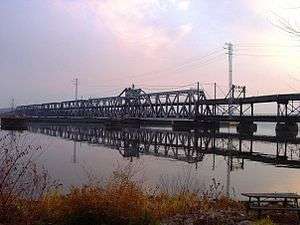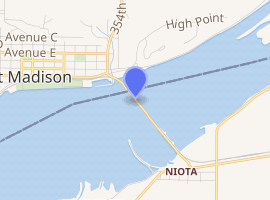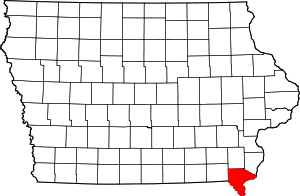Fort Madison Toll Bridge
The Fort Madison Toll Bridge (also known as the Santa Fe Swing Span Bridge for the old Santa Fe Railway) is a tolled, swinging truss bridge over the Mississippi River that connects Fort Madison, Iowa, and unincorporated Niota, Illinois. Rail traffic occupies the lower deck of the bridge, while two lanes of road traffic occupy the upper deck. The double-decker bridge, about a mile long with a swing span of 525 feet (160 m), was the longest and largest double-deck swing-span bridge in the world, when constructed in 1927.[2]It replaced an inadequate combination roadway/single-track bridge completed in 1887. The main river crossing consists of four 270-foot (82 m) Baltimore through truss spans and a swing span made of two equal arms, 266 feet (81 m) long. In 1999, it was listed in the National Register of Historic Places under the title, Fort Madison Bridge, ID number 99001035. It was also documented by the Library of Congress Historic American Engineering Record, survey number HAER IA-62. Construction and photographic details were recorded at the time in Scientific American magazine.
Fort Madison Toll Bridge | |
|---|---|
 | |
| Coordinates | 40°37′37″N 91°17′45″W |
| Carries | 2 lanes of IA 2 and IL 9 and rail lines |
| Crosses | Mississippi River |
| Locale | Fort Madison, Iowa and Niota, Illinois |
| Other name(s) | Santa Fe Swing Span Bridge |
| Maintained by | BNSF Railway |
| History | |
| Opened | July 26, 1927 |
| Statistics | |
| Toll | $3.00 (westbound only), per vehicle |
Fort Madison Bridge | |
| MPS | Highway Bridges of Iowa MPS |
| NRHP reference No. | 99001035[1] |
| Added to NRHP | August 27, 1999 |

| |
The bridge is the eastern terminus of Iowa Highway 2, and the western terminus of Illinois Route 9. Iowa 2 runs westwards towards Farmington, Iowa, about 23 miles (37 km), while Illinois 9 continues eastwards towards Canton, Illinois (about 80 miles (130 km)) and Peoria, about 100 miles (160 km). On July 26, 1927, operations were transferred from the original single-track bridge to the current double-track bridge. The first opening for river traffic occurred at 11:58 a.m. on July 26, 1927, for the scow C. W. Howell, traveling downriver with no barges attached.
The bridge is privately owned by BNSF Railway and is the river crossing for the Southern Transcon, BNSF's Chicago to Southern California main line. About 100 trains a day, including Amtrak's Southwest Chief, cross the bridge. Amtrak's Fort Madison station is 2 miles (3.2 km) west of the bridge.
Per Coast Guard regulations and the BNSF Fort Madison River Bridge operations manual, river traffic has the right-of-way over train and vehicle traffic on the bridge. The length of time for an opening varies due to weather, river current, size and number of boats, and occasional mechanical problems. A typical opening for a tow with 15 barges will take 15 to 20 minutes. The bridge logs over 2,000 openings per year, an average of more than five per day.
Automobile traffic
As of 2018, the upper deck of the Fort Madison Toll Bridge is open to automobile traffic. It is closed to semi-trailer truck traffic. The BNSF, which owns and maintains the bridge has posted the following limits: Gross weight posted as no more than 16,000 Pounds (8 Tons). Width: 8 Ft. Height: 14 Ft. 4 In. Length: 60 Feet.
See also
| Wikimedia Commons has media related to Fort Madison Toll Bridge. |
References
- "National Register Information System". National Register of Historic Places. National Park Service. July 9, 2010.
- Michelle Crow-Dolby. "Fort Madison Bridge". National Park Service. Retrieved 2018-11-27. with photo
- Historic American Engineering Record (HAER) No. IA-62, "Fort Madison Bridge, Spanning Mississippi River at U.S. Highway 61, Fort Madison, Lee County, IA", 14 photos, 1 color transparency, 16 data pages, 1 photo caption page
- Weeks, John. "Fort Madison/Niota Toll Bridge". Retrieved January 18, 2006.
- "Crews Tackle Mississippi River Bridge Work". BNSF. October 10, 2005. Archived from the original on 2006-06-03.
 The Fort Madison Toll Bridge
The Fort Madison Toll Bridge
